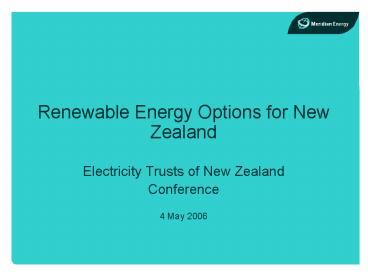Renewable Energy Options for New Zealand - PowerPoint PPT Presentation
1 / 19
Title:
Renewable Energy Options for New Zealand
Description:
... Bank Tunnel ... Mohikinui River, West Coast. Mokihinui Location Plan. Taramakau ... average wind speed is lower than West Wind or Te Apiti, but is ... – PowerPoint PPT presentation
Number of Views:30
Avg rating:3.0/5.0
Title: Renewable Energy Options for New Zealand
1
- Renewable Energy Options for New Zealand
- Electricity Trusts of New Zealand
- Conference
- 4 May 2006
2
Lower Waitaki River, North Otago
North Bank Tunnel Concept
3
North Bank Tunnel Concept - location
- Intake from lake behind Waitaki Dam
- Discharge at Stonewall, above Black Point
- Full river flow below Black Point
4
North Bank Tunnel Concept
- Scheme provisionally sized for a maximum flow of
around 260 cumecs through tunnel. - Scheme power output 200MW 280MW
- Energy 1100GWh 1400GWh (more than enough to
power every house in Christchurch) - One cumec of water through NBTC produces 5-6 more
energy than through Waitaki PS
North Bank Tunnel Concept
5
North Bank Tunnel Concept
- 10m and 12m diameter tunnels considered
- Manapouri 2nd tailrace tunnel is 10m diameter
- Tunnel boring machine (TBM) construction
- 2 or 3 TBMs concurrently deployed
- Tunnel diameter influences scheme size, output
and cost - Construction Period 4.5 6.5 years
North Bank Tunnel Concept
6
Mohaka River, Hawkes Bay
Mohaka River
7
Limit of Conservation Order Willow Flat
Raupunga Site (possible alternative) (M15)
Kakariki Site (M20.5)
Mohaka location
8
Mohaka Possible Lake at Kakariki Site
9
Summary Statistics Base case
- 44MW (may vary depending on live storage options)
- Approximately 210 to 230 GWh
- Capex 150m
- Relatively modest lake 340 ha
- 40 m high dam with mean river flow of 70 cumecs
- Roller Compacted Concrete (RCC) design provides
flood resilience and lower construction risk
Kakariki
10
Mohikinui River, West Coast
Mohikinui River
11
0 km
10 km
Mokihinui Location Plan
12
Mokihinui Possible Impoundment
13
STATISTICS
- Installed Capacity approx. 70 MW
- Flow Mean Flow 90 m3/sec
- Energy approx. 230 GWh (enough energy for
approx. 27,000 houses) - Small reservoir approx 250 ha with 3m storage
capacity - RCC Dam Construction technology
- Rapid construction time and favourable technology
for risk management - Diversion tunnels during construction
- Requires transmission link to Waimangaroa or
Inangahua further work required
Mokihinui Statistics
14
Te Apiti 90MW
West Wind 210MW
White Hill 58MW
Rocklands ???MW
Meridian Wind Developments
15
Rocklands Location
Rocklands - Location
16
Rocklands
- Site is situated on the Lammermoor Range 69km to
the north west of Dunedin City 749m to 1080m
above sea level - Currently used for grazing and as the catchment
area for the local irrigation scheme. - Local communities
- Middlemarch - 15km NE (pop 186)
- Outram 38km SE (pop 609)
- Ranfurly - 40km N (pop 732)
- The average wind speed is lower than West Wind or
Te Apiti, but is still world class by global
standards
Rocklands site features
17
Rocklands
- Development Envelope provides a basis for
effects based studies while allowing the best
technical/commercial solution to be adopted at
the time of construction - 176 feasible turbine positions covering 92km².
- Turbines dimensions
- Rotor diameter up to 120m
- Rotor hub height up to 100m
- Turbines are spaced 600m apart
- Potential turbine generator capacity ranging from
1.8MW to 3.6MW - Output between 300MW and 630MW (depending on the
turbine type) - Connection into the Roxburgh 3 Mile Hill 220kV
transmission circuits that runs across the
project.
Rocklands Development Envelope
18
Rocklands
- Meridian is currently undertaking consultation
with key stakeholders - Depending on feedback from consultation a
Resource Consent application will be lodged in
June - Rocklands is a significant renewable energy
project that has the potential to assist in
meeting New Zealands growing energy demands
Rocklands
19
Thank You































